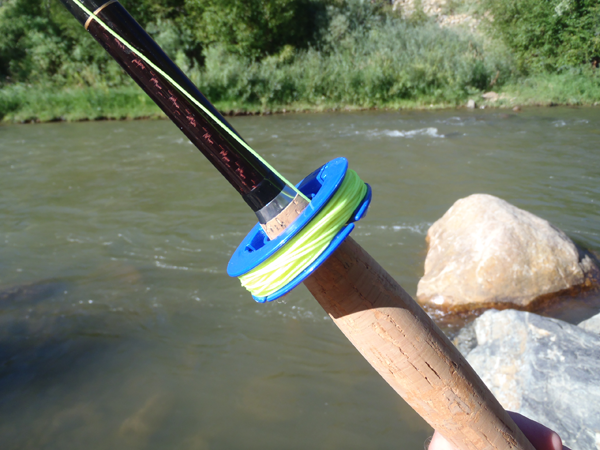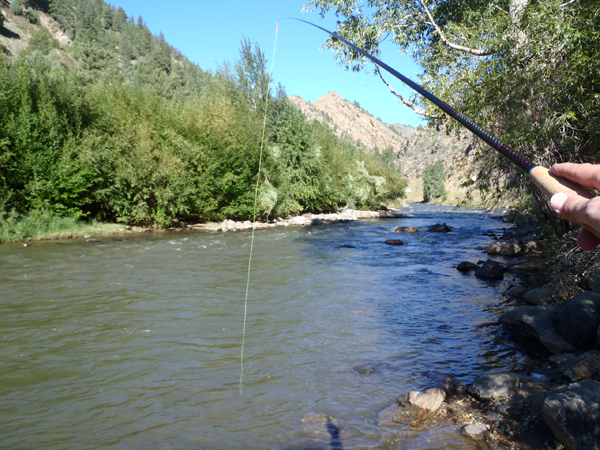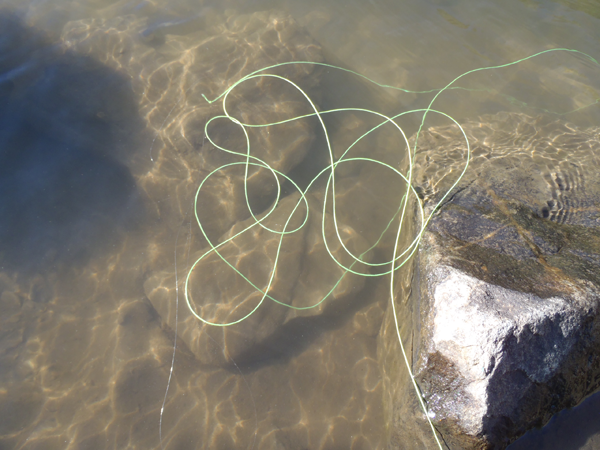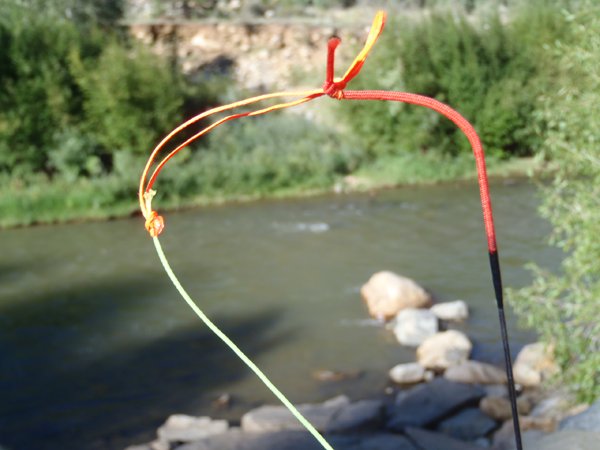A few weeks ago, I wrote a post about using Cortland braided nylon level line for tenkara. I liked how it cast in my backyard, but hand’t had it on the water. That is, until today. And the verdict is in…
While it seemed to be a pretty a good candidate for tenkara, I had some questions that I couldn’t answer in the backyard. Would it float or sink? Would it spray water and scare fish? Will it sag and create drag on the fly? Will it turn into a bird’s nest if I pull it out of a snag?
Today, I got all of those questions answered (and a few I didn’t even anticipate).
I already knew that the line casts well and is much more visible than typical tenkara fluorocarbon level lines. That’s no surprise since it’s a lot thicker. But I was a little surprised at just how visible it really is. It’s basically as visible as regular PVC fly line and is easily trackable against a variety of backgrounds:
It doesn’t spray as I thought it would and it floats temporarily until it becomes water logged when left in the water for a long time. This isn’t a big deal for me since my regular fluorocarbon lines sink anyway and I usually fish subsurface.
Since the line isn’t as light as most tenkara level lines, it is a little more difficult to keep off the water to reduce drag (and to be fair, I was fishing a 16′ line with mostly 13′ rods so a shorter one might have been better). But the extra weight also means it casts really well in the wind. I thought that the thicker diameter would actually be a hindrance in the wind since it would create more resistance. But it turned out to be an asset. I think part of that might be that the weave soaks up some water to make the line heavy enough to punch through the gusts.
The water was high today and I fished a weighted fly for the first time in a long time. And, as you can imagine, weighted flies mean more snags. Despite pulling out three or four snags, the line didn’t recoil into a bird’s nest like most nylon tapered lines. This doesn’t make sense to me and I can’t explain why, but I’ll take it. It’s “snag friendly”.
To connect the line to the rod, I tied about three inches of 30 lb. Dacron backing to the line with an overhand knot, then tied a figure 8 knot in the other end to attach the tippet with a slip knot. I was worried about the rough texture of the braided line not cooperating with the smooth tippet sliding down to meet the stopper knot but it actually worked out perfectly.
One unexpected benefit of this line is that it’s really ergonomic. Fluorocarbon lines are thin, and sometimes hard to grab when handlining a fish in. But the braided line is easy to get a firm grip on because of its textured surface. You might also think that that same textured surface makes it difficult to let a fish run. But it’s actually the opposite. If you just relax the tension a little, the wet line actually has less surface area and slides easily through your hand, creating a highly effective artificial drag system that’s easy to instantly adjust as the battle changes.
Overall, the Cortland braided level running line is a good choice for tenkara. Will it replace your favorite level fluorocarbon lines or furled lines? Maybe not. But it should be added to the mix. Everyone has their preference. And I say for $15 for 100 ft., this line is definitely worth a try to see if it becomes yours.












Jason, I think you said you made this line up out of the 30lb test Cortland in the first post. They make this same hi-viz braid in 20lb test, any thoughts on how that might work. Possibly with a slower (more full-flex) rod? And I guess that brings up another question, what were the characteristics of the rod you were using here?
Lynn, I haven’t had a chance to try both diameters yet but I’m ordering spools of each to test out.
Used it in nearby pond Wednesday. Got six medium perch (bream, whatever) in less than 30 minutes. Super line for relative beginner. Will be trying longer lengths soon. Used loops on both ends of the line. Worked fine with direct connect to lillian. Try it, you’ll like it!.
Morning Jason,
Like your findings. Like you, I’m always looking for new solutions to visibility ( my excuse is old eyes.) and it appears you may have found one. It’ll be interesting to see if the 20 lb running line works as well as the 30. Thanks for you continued laboratory testing for all things Tenkara. It makes life & learning that much more fun. I’m only in Estes for another2weeks then it’s back to our winter HQ in UT. I have an ATV TRIP in UT in October which I plan to Tenkara my way through some small streams and hopefully get this new idea put to the test.
Enjoy your articles. I have a beginner’s question:How do you get your fish in to shore with a 13 foot pole and 16 foot line? Do you telescope the Tekara pole in and draw in the line hand-over-hand? thanks
Hi Luther, you don’t telescope the pole. You tilt the rod back, grab the line, and then pull it hand over hand as you say. It’s not as hard as it sounds. I usually fish a line that’s longer than my rod.
Jason,
Good review of the Cortland Braided line. I am curious about one characteristic of braid line though.
I’ve used braided line on conventional fishing tackle before. If you grab the line when trying to land a fish, braided line will slice your hand like a sharp knife. Is the Cortland Braided line different?
Hi Adrian,
This isn’t a braided line like they sell for spinning or baitcasting. Those are Kevlar or something and will definitely cut your hand. This line is nylon and is very thick so it couldn’t cut your hand.
Thanks Jason. If you are in a small mountain stream 8-12 feet wide with overhanging brush what length Tenkura rod and what length line do you use. The stream (river) you show here is quite wide compared to many streams here in western NC.
Hi Luther, the honest answer is that I never fish streams like that. The streams I fish are pretty wide open so I can use a long rod. Chris Stewart from Tenkara Bum might be a better person to ask. He does more fishing like that than I do.
Thanks Jason.
I’ve been playing around with dacron and PVC coated running (or shooting) lines and, from what a read in this post, i conclude that the braided nylon line is something in between.
I´ll give it a try!
Blatt, cool. Are you having luck casting Dacron? It didn’t turn over very well when I tried it.
Hey Jason, I like your new layout. We have been playing around with small (pvc) running lines here in the east for tuning over big hoppers (credit to mossy creek fly fishing). This line sounds like it can be used for this as well. My question is when you cast does it kick the water out of the line making it float again?
Luther, I am also here in NC and when fishing out tight streams I use a T-USA Iwana with the 9’3″ handle and I favor the 10.5 furled line.
Hi Lance, thanks! The line doesn’t really spray like I thought it would but does seem to float better after being cast so some water must be shaking out. I imagine a few false casts would make it float better. This line would turn over a hopper but if you need something that floats reliably, the running lines your using or something like the Rigs floating line might be better: https://www.tenkaratalk.com/2012/12/floating-tenkara-line-by-rigs/
Jason, it works nice on stiffer rods but i must say that never used a line much bigger than the rod.
I’ve also impregnated some dacron with boiled linseed oil (polimerized linseed oil) like it used to be made with old silk fly lines. The oil after dry adds weight and closes the dacron braid so that is harder to get it water soaked. Because of the extra weight the line turns into an intermediate sinking but if you rub it with some “grease” it will float like cork.
The presentation is very soft with minimum water displacement.
In the end i gave up from “oiling” the dacron cause it is too much work and the pvc coated ones are readily available.
Just wondering where to purchase this line? Sportsman’s Warehouse online his the 20lb in yellow but not the 30lb. Where did you purchase the 30lb yellow? Thanks
Hi Nick. Here you go: http://www.feather-craft.com/?action=display&target=FM006
Any report on the 20lb yet? I’ve pretty much given up on level line as the 30lb Cortland works so much better in any wind.
Hi Mike, sorry, not yet. No time for experimenting or fishing lately.
I have been playing around with the different braided lines I have: the two different weights of Calcutta line and the 30# Cortland and Airflo line, mentioned in the other blog post about the Cortland 30# line.
After looking at this webpage showing how this guy made a tapered line from different weights of level line.
http://www.ukeikai.com/a_others/col_koike/oth_koike.html
I thought why just use the braided fly line as a level line? I could made a tapered line with it by using 30# then 20# shooting line and ending with an end section of FC level line ( as in the Sebata line link also posted in the original blog post.) It would be easy to do by splicing eyes in each end of each section of line. Or make an eye by looping back the end and wrapping it with fly tying thread. And a drop of crazy glue.
The drawing shows how he made a 5 meter tapered line. The formula he used to make the tapered line is not so obvious without some study. But in the text he gives the lengths for making a 10 m line and a 7 m line. For each line he uses the same formula.
Which is 50% of length is the heaviest line, 30% of length is medium wt line, 20% of length from the lightest line + tippet. The formula is most clear when you look at the 10m line.
His line is entirely made of sections of level line of different weights. But perhaps I could assume the formula could work with braided line.
5 meter line = 2.5m ( 7号) + 1.5m (5号) + 1 m (4号) + tippet of 1 ~ 1.5m of size 1 -> 1.5 号 ( = 4X or 3X) nylon or fluorocarbon
7 meter line = 3.5m ( 7号) + 2.1m (5号) + 1.4 m (4号) + tippet
10 meter line = 5m ( 7号) + 3m (5号) + 2 m (4号) + tippet
Whatever weight the heaviest line is the middle line is 2 sizes smaller or 28.6% lighter and the next section is 20% lighter than the middle section or one size smaller.
iow the percentage of weight is about the same ratio as the section lengths.
If you tried this with 30# and 20# Cortland or Airflo shooting line. The weight change would not be much different from the weight change with the FC Level Line he used.
He went from 7号 to 5号. [(5 -7)/7] x 100= – 28.7% If you did the same thing with the Shooting line, if I assume the line weight changed proportional to line rating. Then the change in weight would be [(20 – 30 )/30] x 100 = 33.3%. Close enough. Then from middle section to 3 section he went from 5号 to 4号. A – 20% change is line weight. ( that is by line size,not by weight of the length of the line) So perhaps a change from 20# braided line to a lenght of 4号 FC level line would work out to about a 20% decrease in line weight.
For example to make a 7m ( 24 ft) tapered braided line. Make a section 3.5m from 30# Cortland line. The a 2.1m meter section of 20# Cortland line and lastly a 1.4m long section of 4号 ( or maybe 3.5号) FC level line or even nylon line if you preferred.
Just join each section with a loop to loop connection. Adding on 1m to 1.5 m of tippet and you end up with a total line length of 8m (25.3 ft ) or 8.5m ( 28ft). Which is about as long as I would ever want to use.
I have tried this with the Calcutta line I have and it cast very nicely. I also substituted the 30# Cortland and Airflo line for the center length and it also rolled out pretty nicely. But I don’t think it balanced as nicely as the all Calcutta line. Now I want to get some of the 20# Cortland line and try it too.
Also by joining the lines with loop to loop. If you don’t want to cast the tapered braided line. And would rather cast a 7m line of all 30# braided line or all 20#. No need for a separate 7m line. Just take the original 3.5m of 30# line. Make another just like it, 3.5m, and loop to loop connect it to the first line and you have a 7m 30# line. The loop to loop connection doesn’t seem to effect the casting of the line. Don’t make the eye loops to big. But also don’t make them so small it is difficult to push the eye from the other line through them to make the loop to loop connection.
And fwiw. I was reading on the yoshidakebari website a post where he compared the advantages and disadvantages of Shooting line v furled tapered line v FC level line. He recommended the Shooting line and tapered lines, of not to long a length, for beginners, because heavier line is easier to cast than the lighter FC level line.
But he also advised that the color of the shooting line may spook the fish and to off set that by using longer tippet. But longer tippet requires more line speed to roll it out to full extension. And you will have more trouble with Otsuri, which is the fly whipping around and landing short of full extension. Just his opinion. I’d just use a 1 m tippet and if not catching any fish, then maybe the color of the braided line is spooking the fish.
( and if you have the casting skill to generate enough line speed to roll out 2 m of tippet. Then you also have the the casting skill to generate enough line speed to cast a long 3 or 3.5号 FC level line)
However, I think the color of the braided line would not be a problem if your third section of the line is a length of FC level line before the tippet. As described above or in the Sebata drawing where he always used a .5 m length of FC level line at the end of his braided line, no matter how long the braided line was.
For reference here is a link to the beginners 5 m line he recommended. 4.5m of braided line + .5m of FC level line.
http://www.ukeikai.com/a_others/tenkara_t/t04/tenkara_t04.html
And the other drawing where he shows a 5.5m braided line + .5m of FC level line.
http://www.ukeikai.com/a_others/tenkara_t/t02/tenkara_t02.html
Worth trying. I think.
FYI- I followed the link you had posted for finding the Hi vis 30lb Cortland braided line. It is no longer available. Either 20 lb or 50 lb is all they sell now.